Analysis of the Performance of Various PV Module Technologies in Peru
Abstract
1. Introduction
2. Materials and Methods
2.1. Experimental Setup
2.2. Calculated Parameters and Performance Metrics
3. Results and Discussion
3.1. Monthly Yields
3.2. Monthly Performance Metrics
3.3. Annual Yields and Annual Performance Ratio
4. Conclusions
Author Contributions
Funding
Acknowledgments
Conflicts of Interest
Abbreviations
| Terminology | |
| AC | Alternating current |
| Af | Tropical rainforest climate |
| Am | Tropical monsoon climate |
| a-Si | Amorphous silicon |
| a-Si/µc-Si | Amorphous silicon/microcrystalline silicon heterojunction |
| Aw | Tropical savanna climate |
| Bsh | Hot semi-arid climate |
| Bsk | Cold semi-arid climate |
| Bwh | Hot desert climate |
| BwK | Cold desert climate |
| Cfb | Oceanic climate |
| CIGS | Copper indium gallium selenide |
| c-Si | Crystalline silicon |
| CWb | Subtropical highland climate |
| DC | Direct current |
| GDP | Gross Domestic Product |
| HIT | Heterojunction with intrinsic thin layer |
| IEC | International Electrotechnical Commission |
| mc-Si | Polycrystalline silicon |
| Osinergmin | Peruvian Supervisory Agency of Investment on Energy and Mining |
| PERC | Passivated Emitter and Rear Cell |
| PV | Photovoltaic(s) |
| PVGCS | Photovoltaic grid-connected system |
| PVRD | Photovoltaic reference device |
| RTD | Resistive thermal detectors |
| sc-Si | Monocrystalline silicon |
| STC | Standard Test Conditions |
| Symbols | |
| Aa | Total module area (m2) |
| EA | Monthly DC energy (Wh) |
| Eout | Monthly PV module AC output (Wh) |
| Gi | Monthly in-plane irradiance (W·m−2) |
| Gi,k | k-th recorded value of the in-plane irradiance (W·m−2) |
| G* | Reference in-plane irradiance (1000 W·m−2) |
| Hi | Monthly in-plane irradiation (Wh·m−2) |
| m | Number of instances recorded during a month |
| PA (Gi, 25 °C) | Power output of the PV field corrected at 25 °C (W) |
| PA,k | k-th recorded value of the input DC power (W) |
| Pout | Output AC power (W) |
| Pout,k | k-th recorded value of the output AC power (W) |
| P0 | PV module rating (W) |
| PR | Monthly performance ratio |
| PRannual | Annual performance ratio |
| PRDC | Monthly DC performance ratio |
| PRDC,annual | Annual DC performance ratio |
| Tamb | Ambient temperature (°C) |
| Tmod | Module temperature (°C) |
| YA | Monthly PV array energy yield (Wh·W−1) |
| YA,annual | Annual PV array energy yield (Wh·W−1) |
| Yf | Monthly final PV system yield (Wh·W−1) |
| Yf,annual | Annual final PV system yield (Wh·W−1) |
| Yr | Monthly reference yield (Wh·W−1) |
| Yr,annual | Annual reference yield (Wh·W−1) |
| ηeff | Normalized efficiency |
| τk | Duration of the k-th recording interval (h) |
References
- Fraunhofer ISE. Available online: https://www.ise.fraunhofer.de/content/dam/ise/de/documents/publications/studies/Photovoltaics-Report.pdf (accessed on 7 December 2018).
- Photon International. Markets worldwide. The Solar Power Magazine, September 2018; no. 9. 8. [Google Scholar]
- Erge, T.; Hoffmann, V.U.; Kiefer, K. The German experience with grid-connected PV-systems. Solar Energy 2001, 70, 479–487. [Google Scholar] [CrossRef]
- Pietruszko, S.M.; Gradzki, M. Performance of a grid connected small PV system in Poland. Appl. Energy 2003, 74, 177–184. [Google Scholar] [CrossRef]
- Hontoria, L.; Aguilera, J.; Almonacid, F.; Nofuentes, G.; Zufiria, P. Artificial Intelligence in Energy and Renewable Energy Systems; Kalogirou, S., Ed.; Nova Publishers Inc.: Chichester, UK, 2006; pp. 163–200. [Google Scholar]
- Muñoz, F.J.; Almonacid, G.; Nofuentes, G.; Almonacid, F. A new method based on charge parameters to analyse the performance of stand-alone photovoltaic systems. Sol. Energy Mater. Sol. Cells 2006, 90, 1750–1763. [Google Scholar] [CrossRef]
- Bakos, G.C. Distributed power generation: A case study of small scale PV power plant in Greece. Appl. Energy 2009, 86, 1757–1766. [Google Scholar] [CrossRef]
- Zou, X.; Li, B.; Zhai, Y.; Liu, H. Performance monitoring and test system for grid-connected photovoltaic systems. In Proceedings of the 2012 Asia-Pacific Power and Energy Engineering Conference, Shanghai, China, 27–29 March 2012. [Google Scholar]
- Congedo, P.M.; Malvoni, M.; Mele, M.; De Giorgi, M.G. Performance measurements of monocrystalline silicon PV modules in South-eastern Italy. Energy Convers. Manag. 2013, 68, 1–10. [Google Scholar] [CrossRef]
- Micheli, D.; Alessandrini, S.; Radu, R.; Casula, I. Analysis of the outdoor performance and efficiency of two grid connected photovoltaic systems in northern Italy. Energy Convers. Manag. 2014, 80, 436–445. [Google Scholar] [CrossRef]
- Adaramola, M.S.; Vågnes, E.E.T. Preliminary assessment of a small-scale rooftop PV-grid tied in Norwegian climatic conditions. Energy Convers. Manag. 2015, 90, 458–465. [Google Scholar] [CrossRef]
- Milosavljević, D.D.; Pavlović, T.M.; Piršl, D.S. Performance analysis of A gridconnected solar PV plant in Niš, republic of Serbia. Renew. Sustain. Energy Rev. 2015, 44, 423–435. [Google Scholar] [CrossRef]
- Phinikarides, A.; Makrides, G.; Zinsser, B.; Schubert, M.; Georghiou, G.E. Analysis of photovoltaic system performance time series: Seasonality and performance loss. Renew. Energy 2015, 77, 51–63. [Google Scholar] [CrossRef]
- De Prada-Gil, M.; Domínguez-García, J.L.; Trilla, L.; Gomis-Bellmunt, O. Technical and economic comparison of various electrical collection grid configurations for large photovoltaic power plants. IET Renew. Power Gener. 2017, 11, 226–236. [Google Scholar] [CrossRef]
- Kazem, H.A.; Khatib, T.; Sopian, K.; Elmenreich, W. Performance and feasibility assessment of a 1.4 kW roof top grid-connected photovoltaic power system under desertic weather conditions. Energy Build. 2014, 82, 123–129. [Google Scholar] [CrossRef]
- Eke, R.; Demircan, H. Performance analysis of a multi crystalline Si photovoltaic module under Mugla climatic conditions in Turkey. Energy Convers. Manag. 2013, 65, 580–586. [Google Scholar] [CrossRef]
- Edalati, S.; Ameri, M.; Iranmanesh, M. Comparative performance investigation of mono- and poly-crystalline silicon photovoltaic modules for use in grid-connected photovoltaic systems in dry climates. Appl. Energy 2015, 160, 255–265. [Google Scholar] [CrossRef]
- Al-Otaibi, A.; Al-Qattan, A.; Fairouz, F.; Al-Mulla, A. Performance evaluation of photovoltaic systems on Kuwaiti schools’ rooftop. Energy Convers. Manag. 2015, 95, 110–119. [Google Scholar] [CrossRef]
- Ferrada, P.; Araya, F.; Marzo, A.; Fuentealba, E. Performance analysis of photovoltaic systems of two different technologies in a coastal desert climate zone of Chile. Solar Energy 2015, 114, 356–363. [Google Scholar] [CrossRef]
- Urrejola, E.; Antonanzas, J.; Ayala, P.; Salgado, M.; Ramírez-Sagner, G.; Cortés, C.; Pino, A.; Escobar, R. Effect of soiling and sunlight exposure on the performance ratio of photovoltaic technologies in Santiago, Chile. Energy Convers. Manag. 2016, 114, 338–347. [Google Scholar] [CrossRef]
- Kottek, M.; Grieser, J.; Beck, C.; Rudolf, B.; Rubel, F. World map of the Köppen–Geiger climate classification updated. Meteorol. Z. 2006, 15, 259–263. [Google Scholar] [CrossRef]
- The World Bank. Available online: http://www.worldbank.org/en/country/peru/overview (accessed on 4 December 2018).
- International Energy Agent. Available online: https://www.iea.org/statistics (accessed on 11 December 2018).
- Zambrano-Monserrate, M.A.; Silva-Zambrano, C.A.; Davalos-Penafiel, J.L.; Zambrano-Monserrate, A.; Ruano, M.A. Testing environmental Kuznets curve hypothesis in Peru: The role of renewable electricity, petroleum and dry natural gas. Renew. Sustain. Energy Rev. 2018, 82, 4170–4178. [Google Scholar] [CrossRef]
- Photon International. Markets worldwide. The Solar Power Magazine, May 2018; no. 5. 22. [Google Scholar]
- Osinergmin. Available online: https://www.osinergmin.gob.pe/ (accessed on 5 December 2018). (In Spanish).
- SolarPack. Available online: https://www.solarpack.es/pais/peru/ (accessed on 5 December 2018). (In Spanish).
- Martinez-Plaza, D.; Abdallah, A.; Figgis, B.W.; Mirza, T. Performance improvement techniques for photovoltaic systems in Qatar: Results of first year of outdoor exposure. Energy Procedia 2015, 77, 386–396. [Google Scholar] [CrossRef]
- European Commission. Available online: http://re.jrc.ec.europa.eu/pvg_tools/en/tools.html (accessed on 10 November 2018).
- PVSYST. Available online: http://www.pvsyst.com/en/ (accessed on 20 September 2018).
- Nasa Prediction of Wordlwide Energy Resources. Available online: https://eosweb.larc.nasa.gov/sse/ (accessed on 10 November 2018).
- Nofuentes, G.; Almonacid, G. Design tools for the electrical configuration of architecturally-integrated PV in buildings. Prog. Photovolt. Res. Appl. 1999, 7, 475–488. [Google Scholar] [CrossRef]
- Muñoz, J.V.; Nofuentes, G.; Aguilera, J.; Fuentes, M.; Vidal, P.G. Procedure to carry out quality checks in photovoltaic grid-connected systems: Six cases of study. Appl. Energy 2011, 88, 2863–2870. [Google Scholar] [CrossRef]
- IEC 61724-1:2017. Photovoltaic System Performance Monitoring—Guidelines for Measurement, Data Exchange and Analysis; IEC Standard; IEC: Geneva, Switzerland, 2017. [Google Scholar]
- Dunn, L.; Gostein, M.; Emery, K. Comparison of pyranometers vs. PV reference cells for evaluation of PV array performance. In Proceedings of the 38th IEEE Photovoltaic Specialists Conference, Austin, TX, USA, 3–8 June 2012. [Google Scholar]
- Osterwald, C.R.; Emery, K.A.; Muller, M. Photovoltaic module calibration value versus optical air mass: The air mass function. Prog. Photovolt. Res. Appl. 2012, 22, 560–573. [Google Scholar] [CrossRef]
- Caballero, J.A.; Fernández, E.F.; Theristis, M.; Almonacid, F.; Nofuentes, G. Spectral Corrections Based on Air Mass, Aerosol Optical Depth, and Precipitable Water for PV Performance Modeling. IEEE J. Photovolt. 2018, 8, 552–558. [Google Scholar] [CrossRef]
- Ye, J.Y.; Reindl, T.; Aberle, A.G.; Walsh, T.M. Performance degradation of various PV module technologies in tropical Sigapore. IEEE J. Photovolt. 2014, 4, 1288–1294. [Google Scholar] [CrossRef]
- Ozden, T.; Akinoglu, B.G.; Turan, R. Long term outdoor performances of three different on-grid PV arrays in central Anatolia—An extended analysis. Renew. Energy 2017, 101, 182–195. [Google Scholar] [CrossRef]
- De Parra, I.; Muñoz, M.; Lorenzo, E.; García, M.; Marcos, J.; Martínez-moreno, F. PV performance modelling: A review in the light of quality assurance for large PV plants. Renew. Sustain. Energy Rev. 2017, 78, 780–797. [Google Scholar] [CrossRef]
- Mavromatakis, F.; Vignola, F.; Marion, B. Low irradiance losses of photovoltaic modules. Solar Energy 2017, 157, 496–506. [Google Scholar] [CrossRef]
- Kenny, R.P.; Vigano, D.; Salis, E.; Bardizza, G.; Norton, M.; Müllejans, H.; Zaaiman, W. Power rating of photovoltaic modules including validation of procedures to implement IEC61853-1 on solar simulators and under natural sunlight. Prog. Photovolt. Res. Appl. 2013, 21, 1384–1399. [Google Scholar] [CrossRef]
- Ye, J.Y.; Reindl, T.; Aberle, A.G.; Walsh, T.M. Effect of solar spectrum on the performance of various thin-film PV module technologies in tropical Singapore. IEEE J. Photovolt. 2014, 4, 1268–1274. [Google Scholar] [CrossRef]
- Amillo, A.M.G.; Huld, T.; Vourlioti, P.; Müller, R.; Norton, M. Application of Satellite-Based Spectrally-Resolved Solar Radiation Data to PV Performance Studies. Energies 2015, 8, 3455–3488. [Google Scholar] [CrossRef]
- Nofuentes, G.; de la Casa, J.; Solís-Alemán, E.M.; Fernández, E.F. Spectral impact on PV performance in mid-latitude sunny inland sites: Experimental vs. modelled results. Energy 2017, 141, 1857–1868. [Google Scholar] [CrossRef]
- Kichou, S.; Abaslioglu, E.; Silvestre, S.; Nofuentes, G.; Torres-Ramírez, M.; Chouder, A. Study of degradation and evaluation of model parameters of micromorph silicon photovoltaic modules under outdoor long term exposure in Jaén, Spain. Energy Convers. Manag. 2016, 120, 109–119. [Google Scholar] [CrossRef]
- Martin, N.; Ruiz, J. Calculation of the PV modules angular losses under field conditions by means of an analytical model. Sol. Energy Mater. Sol. Cells 2001, 70, 25–38. [Google Scholar] [CrossRef]
- Martin, N.; Ruiz, J. Corrigendum to calculation of the PV modules angular losses under field conditions by means of an analytical model. Sol. Energy Mater. Sol. Cells 2013, 110, 154. [Google Scholar] [CrossRef]
- Costa, S.C.S.; Diniz, A.S.A.C.; Kazmerski, L.L. Solar energy dust and soiling R&D progress: Literature review update for 2016. Renew. Sustain. Energy Rev. 2018, 82, 2504–2536. [Google Scholar]
- Salim, A.; Huraib, F.; Eugenio, N. PV power-study of system options and optimization. In Proceedings of the 8th European PV Solar Energy Conference, Florence, Italy, 9–13 May 1988. [Google Scholar]
- Al-Sabounchi, A.; Yalyali, S.; Al-Thani, H. Design and performance evaluation of a photovoltaic grid-connected system in hot weather conditions. Renew. Energy 2013, 53, 71–78. [Google Scholar] [CrossRef]
- Adinoyi, M.; Said, S. Effect of dust accumulation on the power outputs of solar photovoltaic modules. Renew. Energy 2013, 60, 633–636. [Google Scholar] [CrossRef]
- Jordan, D.C.; Kurtz, S.R.; Vansant, K.; Newmiller, J. Compendium of photovoltaic degradation rates. Prog. Photovolt. Res. Appl. 2016, 24, 978–989. [Google Scholar] [CrossRef]
- Schweiger, M.; Bonilla, J.; Herrmann, W.; Gerber, A. Performance stability of photovoltaic modules in different climates. Prog. Photovolt. Res. Appl. 2017, 25, 968–981. [Google Scholar] [CrossRef]
- Nofuentes, G.; Aguilera, J.; Santiago, R.L.; de la Casa, J.; Hontoria, L. A reference-module-based procedure for outdoor estimation of crystalline silicon PV module peak power. Prog. Photovolt. Res. Appl. 2006, 14, 77–87. [Google Scholar] [CrossRef]
- Nofuentes, G.; de la Casa, J.; Torres-Ramírez, M.; Alonso-Abella, M. Solar spectral and module temperature influence on the outdoor performance of thin film PV modules deployed on a sunny inland site. Int. J. Photoenergy 2013, 2013, 620127. [Google Scholar] [CrossRef]
- Abdallah, A.; Martinez, D.; Figgis, B.; El Daif, O. Performance of Silicon Heterojunction Photovoltaic modules in Qatar climatic conditions. Renew. Energy 2016, 97, 860–865. [Google Scholar] [CrossRef]
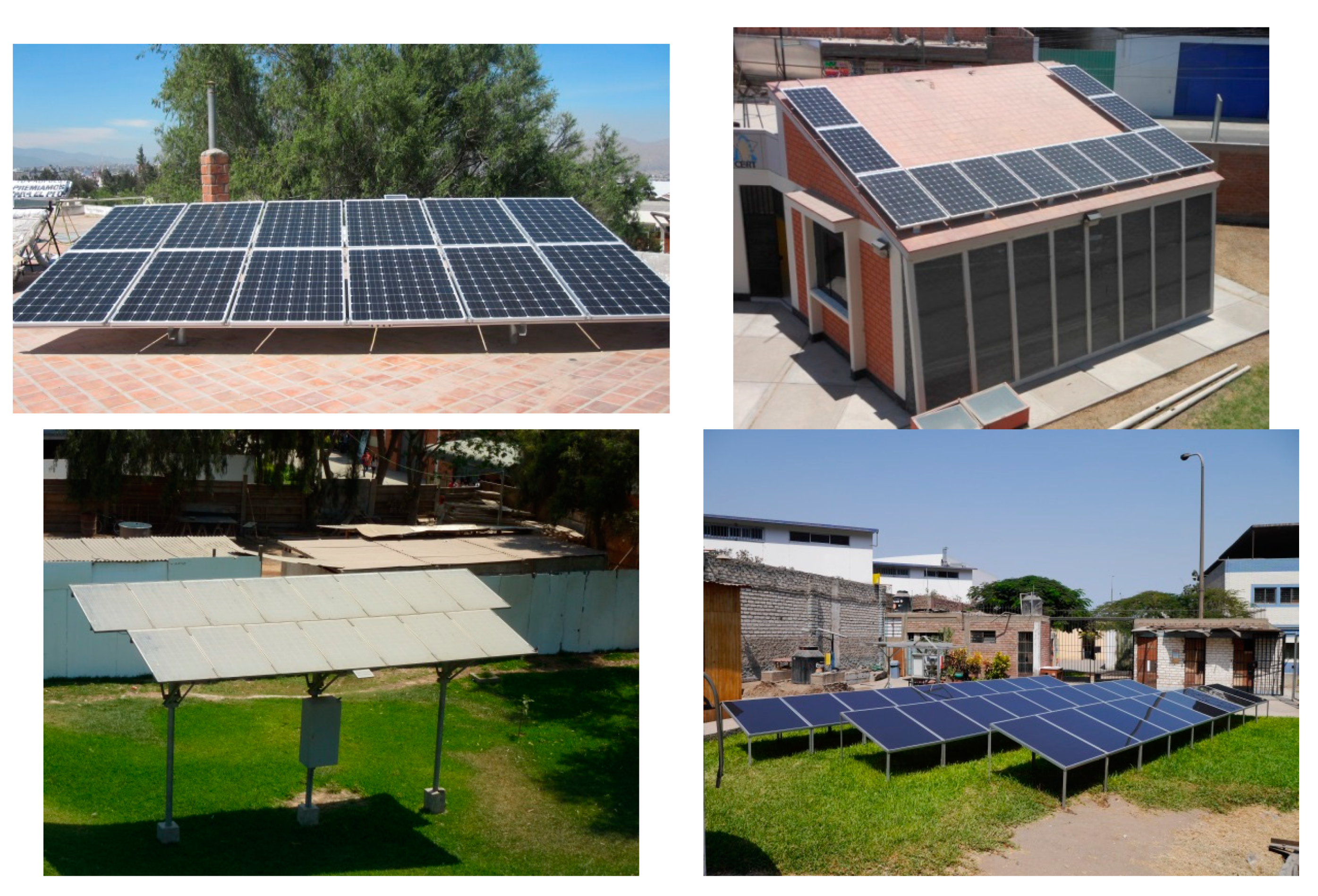
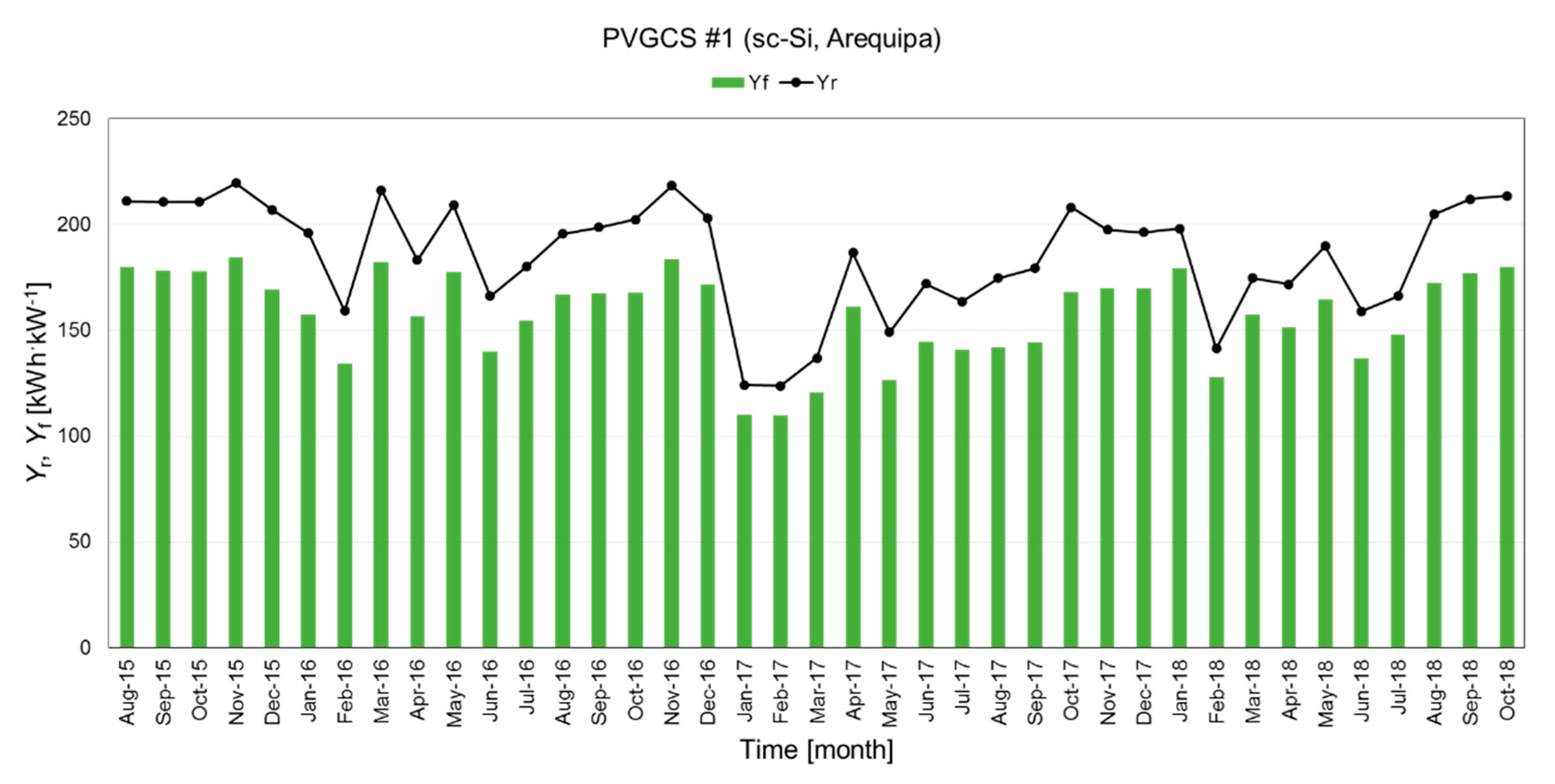
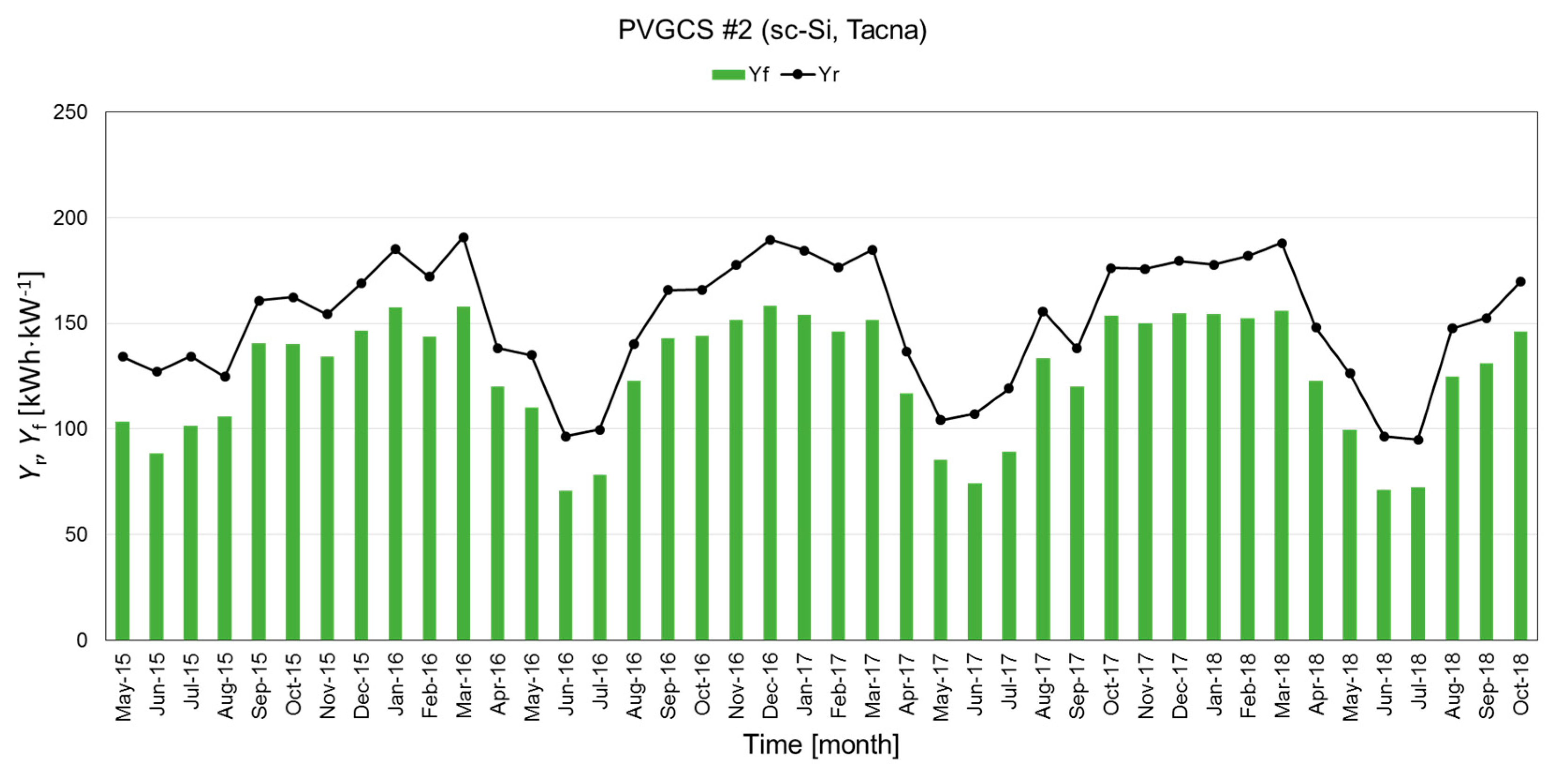
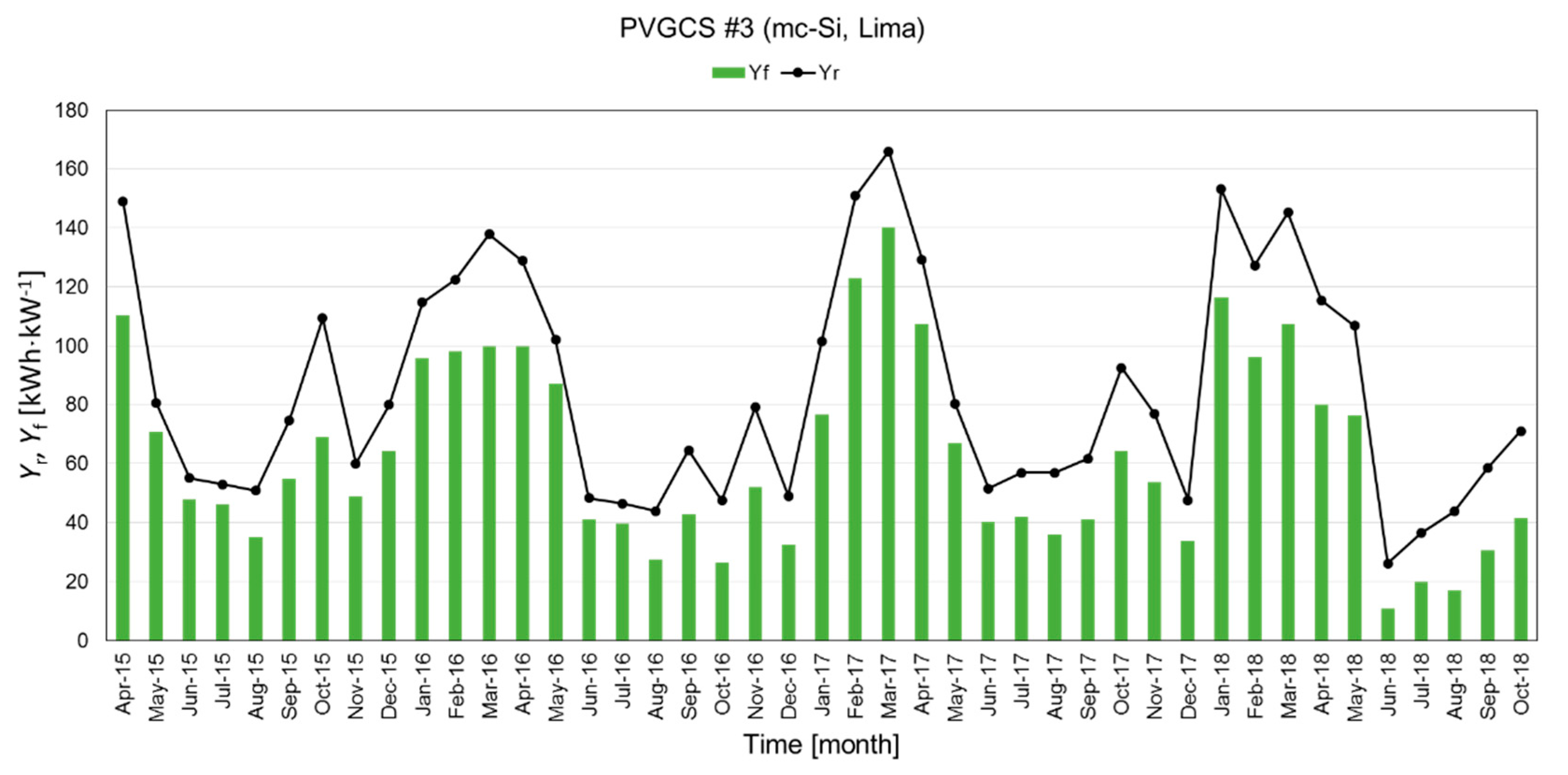
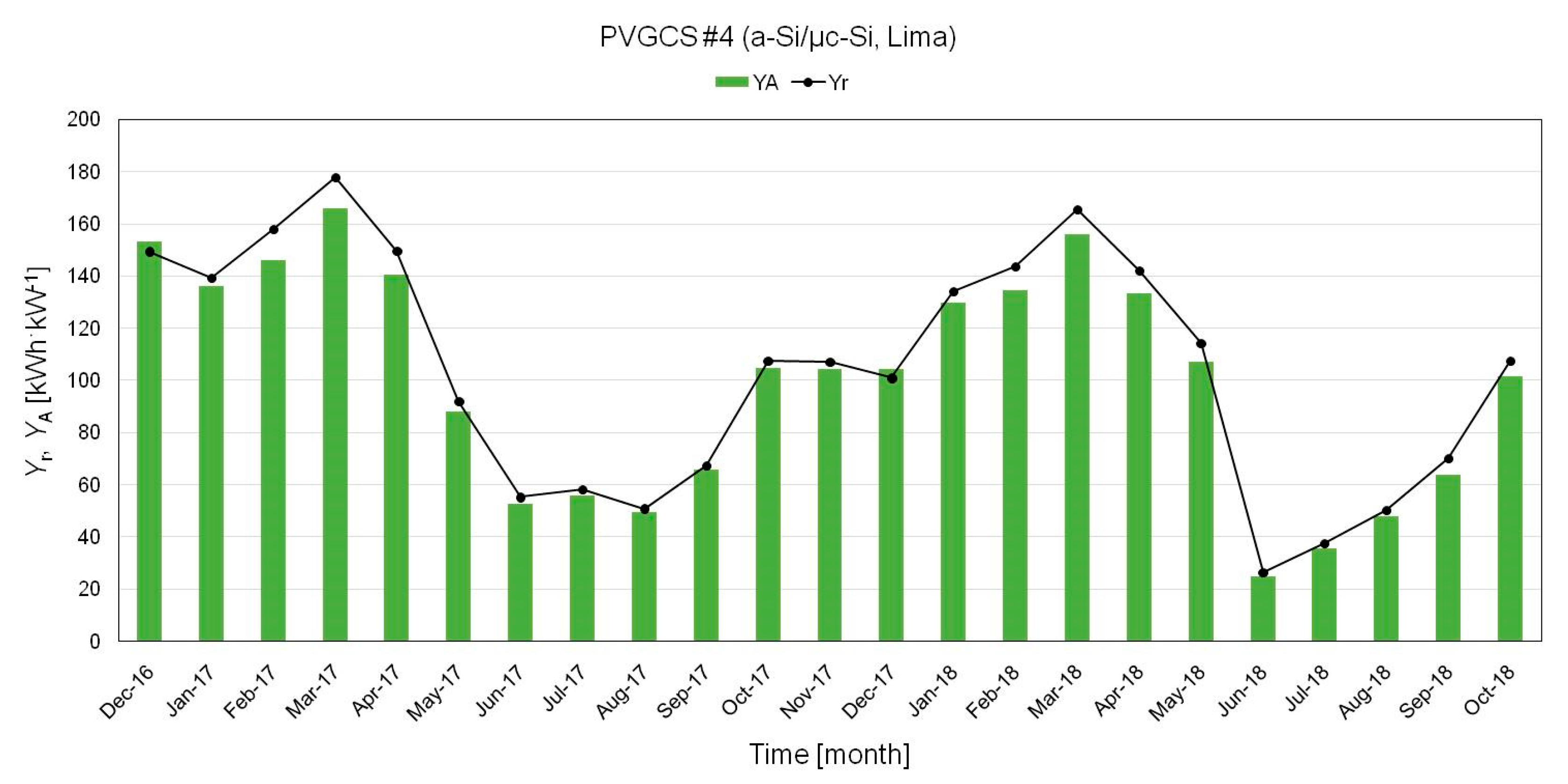
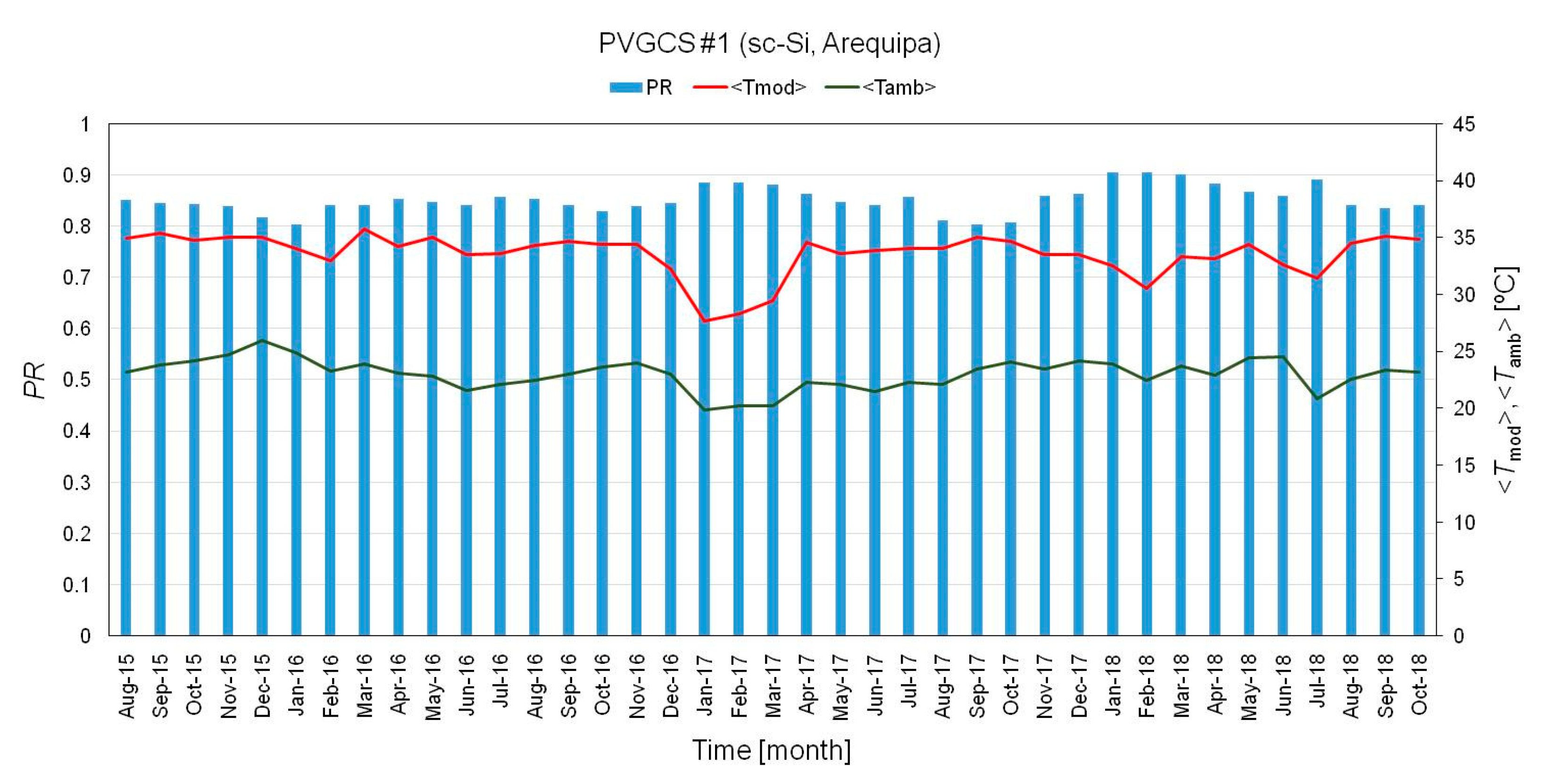
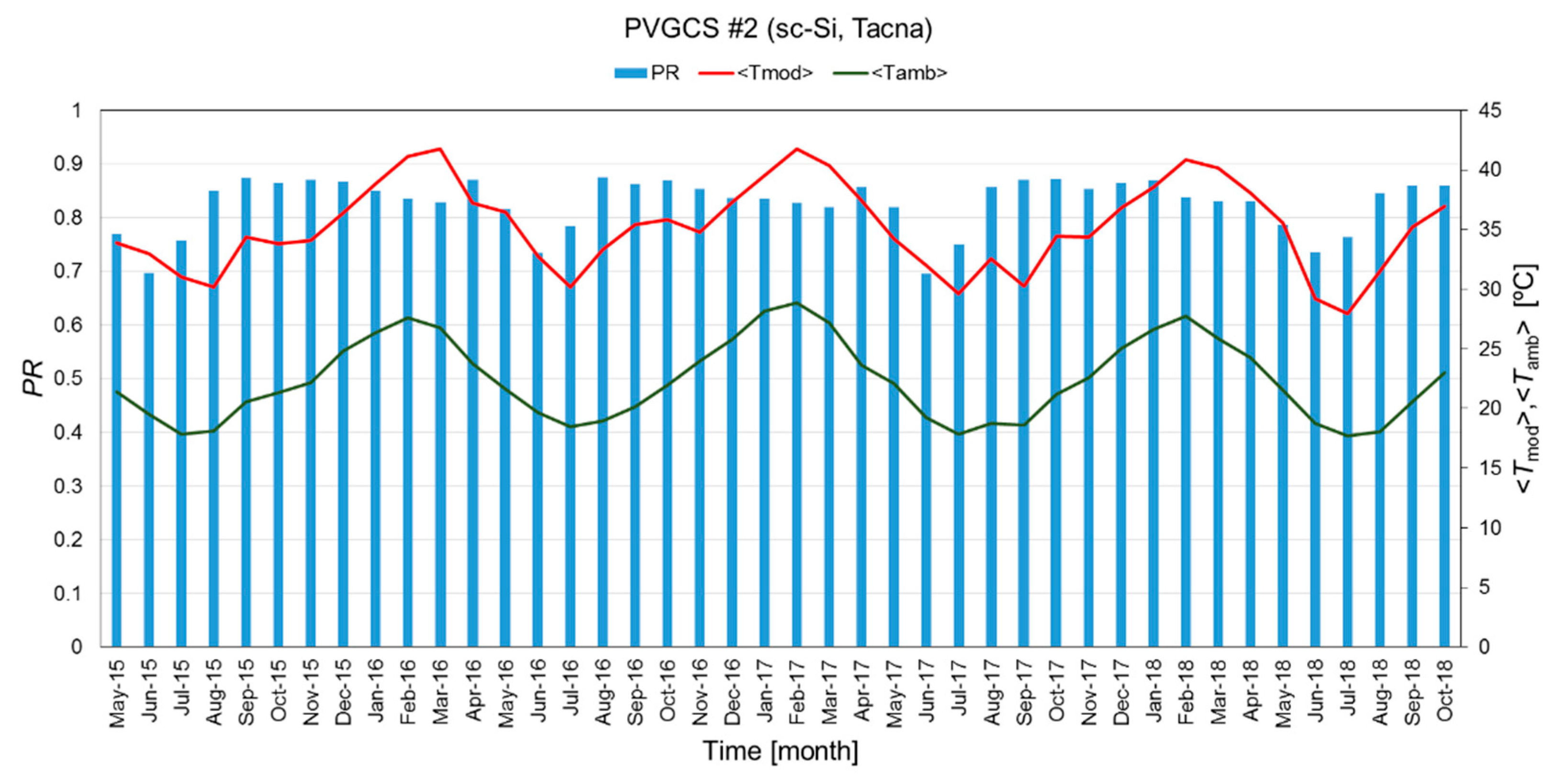
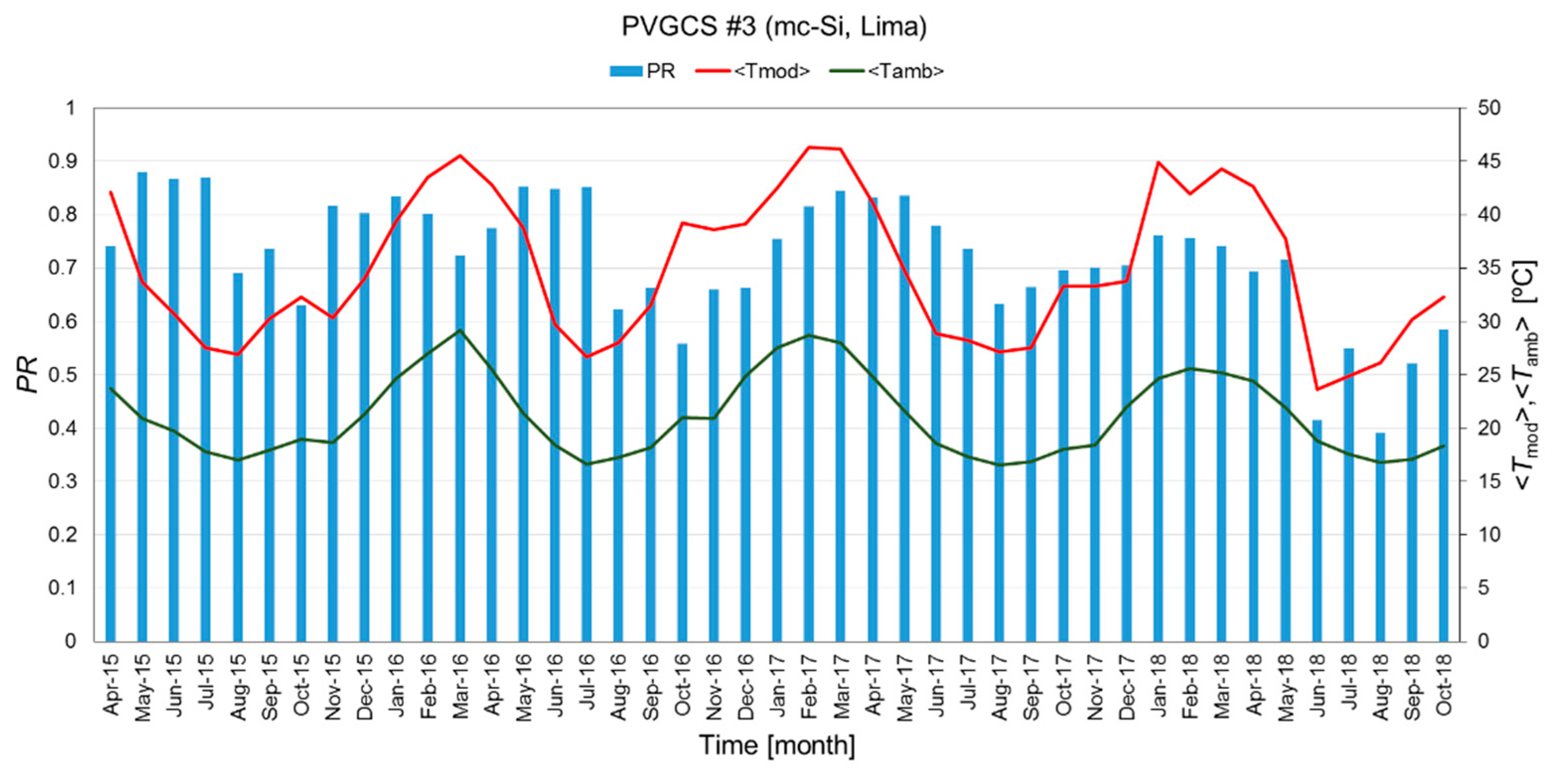
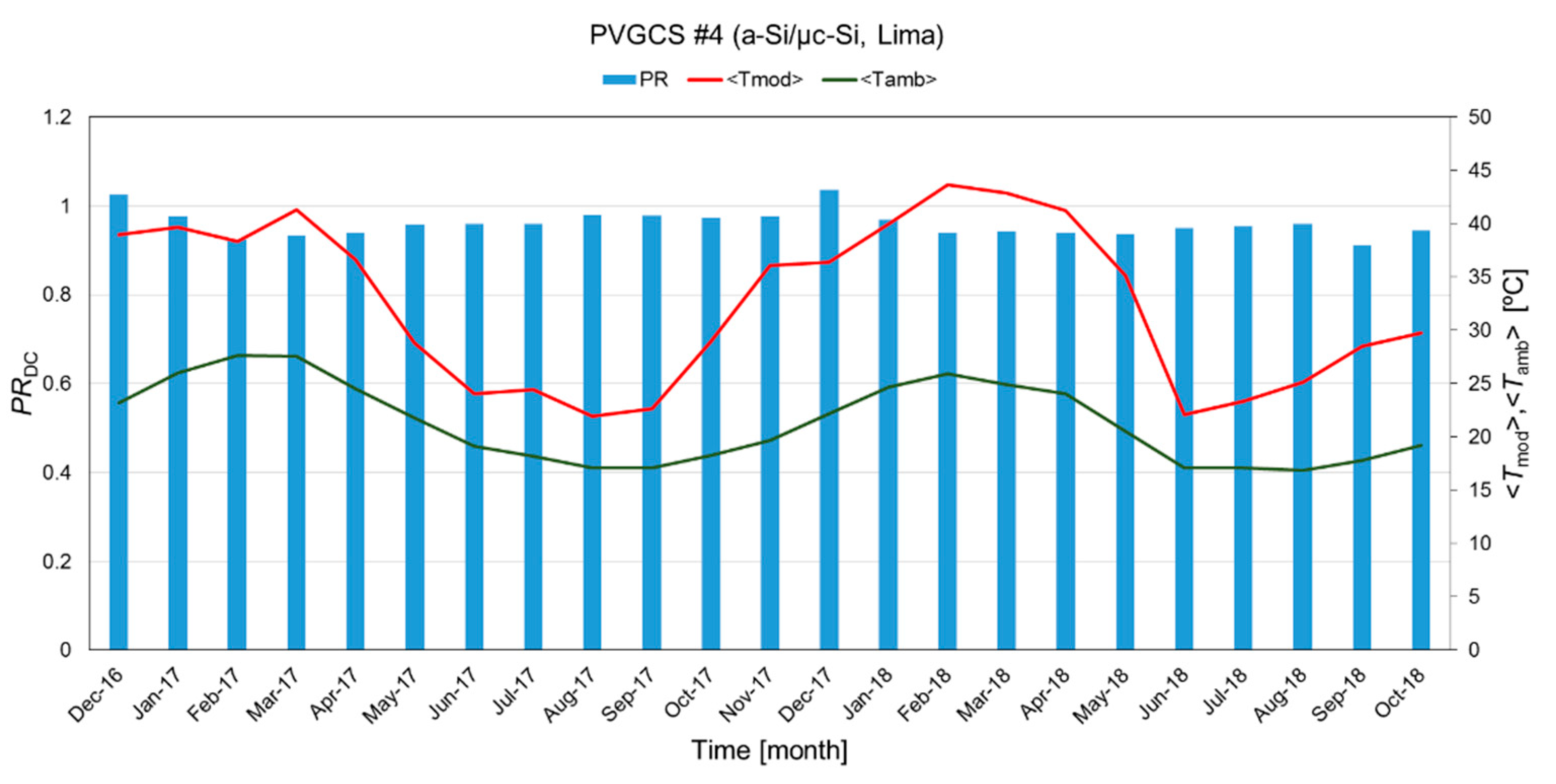
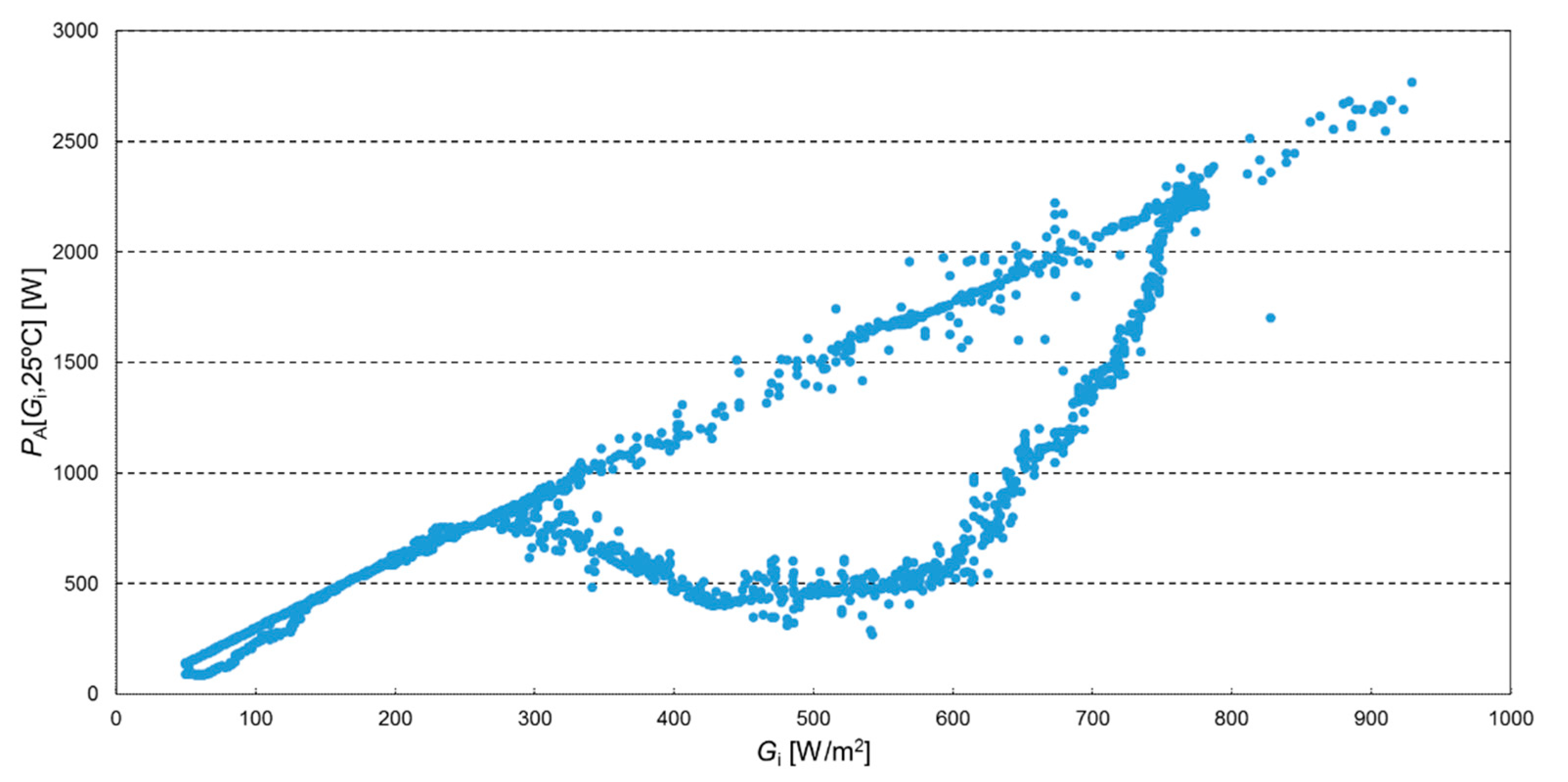
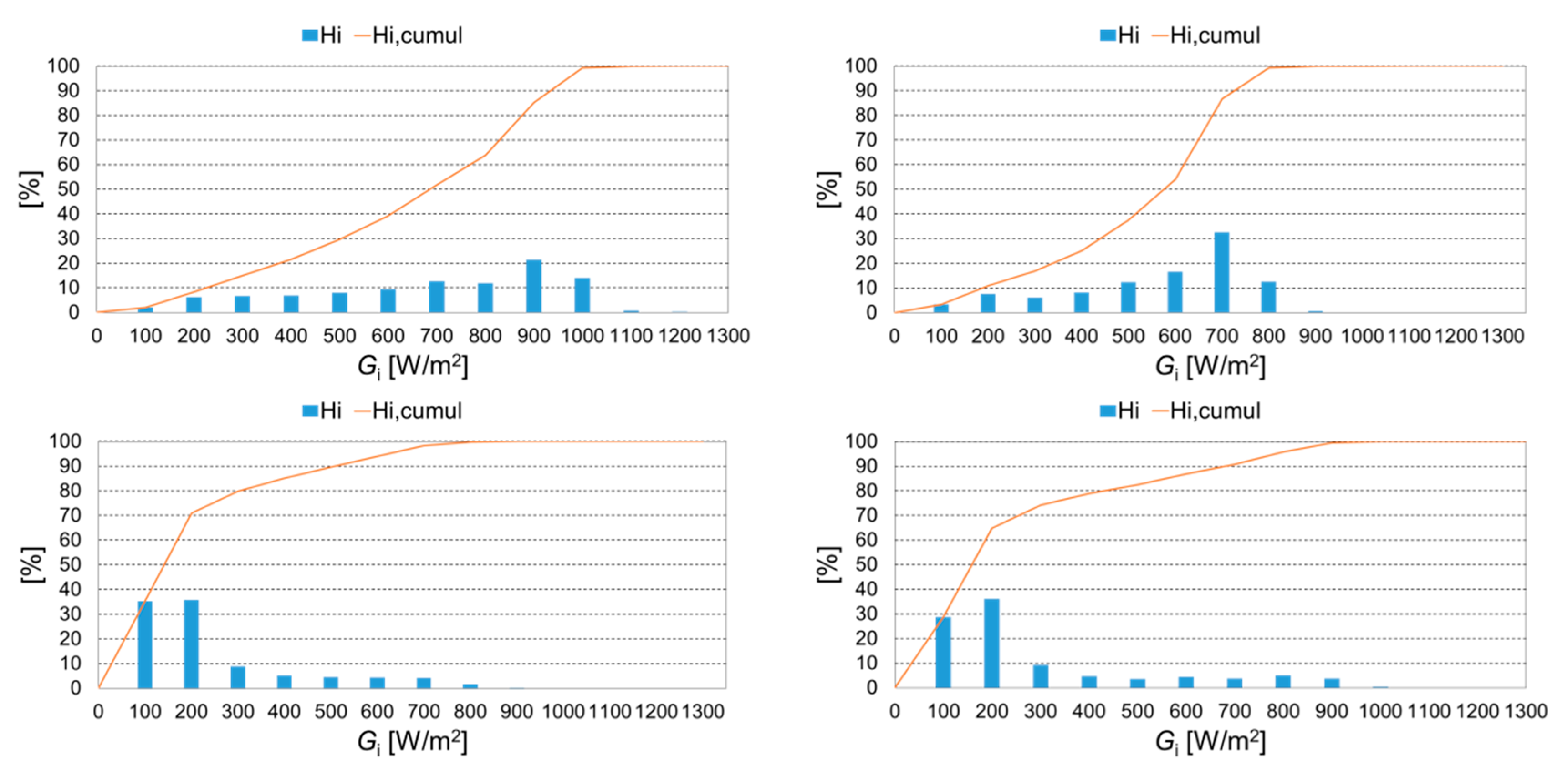
| Meteorological parameter | Arequipa | Tacna | Lima |
|---|---|---|---|
| Horizontal irradiation (kWh·m−2) [29] | 2380 | 2280 | 1740 |
| Ambient temperature (°C) [30] | 12.9 | 16.7 | 18.5 |
| Minimum ambient temperature (°C) [31] | 8.1 | 13.4 | 18.8 |
| Maximum ambient temperature (°C) [31] | 32 | 31.5 | 18.9 |
| Electrical parameter | PVGCS #1 and #2 (Arequipa and Tacna, sc-Si) | PVGCS #3 (Lima, mc-Si) | PVGCS #4 1 (Lima, a-Si/µc-Si) |
|---|---|---|---|
| Maximum power at STC (W) | 3300 | 3010 | 2304 |
| Short-circuit current at STC (A) | 8.9 | 8 | 6.9 |
| Open-circuit voltage at STC (V) | 460 | 511 | 538 |
| Module maximum power Temperature coefficient (°C−1) | −0.0045 | −0.0045 | −0.0024 |
| Period | PVGCS #1 (Arequipa, sc-Si) Yf,annual/Yr,annual | PVGCS #2 (Tacna, sc-Si) Yf,annual/Yr,annual | PVGCS #3 (Lima, mc-Si) Yf,annual/Yr,annual | PVGCS #4 (Lima, a-Si/µc-Si) YA,annual/Yr,annual 1 |
|---|---|---|---|---|
| Aug 2015–Jul 2016 | 1992/2343 | 1505/1792 | 833/1082 | - |
| Aug 2016–Jul 2017 | 1770/2107 | 1537/1852 | 778/1023 | - |
| Aug 2017–Jul 2018 | 1860/2214 | 1540/1855 | 736/1090 | 1338/1380 |
| Period | PVGCS #1 (Arequipa, sc-Si) | PVGCS #2 (Tacna, sc-Si) | PVGCS #3 (Lima, mc-Si) | PVGCS #4 (Lima, a-Si/µc-Si) |
|---|---|---|---|---|
| Aug 2015–Jul 2016 | 0.85 | 0.83 | 0.77 | - |
| Aug 2016–Jul 2017 | 0.84 | 0.82 | 0.76 | - |
| Aug 2017-Jul 2018 | 0.84 | 0.81 | 0.70 | 0.97 |
© 2019 by the authors. Licensee MDPI, Basel, Switzerland. This article is an open access article distributed under the terms and conditions of the Creative Commons Attribution (CC BY) license (http://creativecommons.org/licenses/by/4.0/).
Share and Cite
Romero-Fiances, I.; Muñoz-Cerón, E.; Espinoza-Paredes, R.; Nofuentes, G.; De la Casa, J. Analysis of the Performance of Various PV Module Technologies in Peru. Energies 2019, 12, 186. https://doi.org/10.3390/en12010186
Romero-Fiances I, Muñoz-Cerón E, Espinoza-Paredes R, Nofuentes G, De la Casa J. Analysis of the Performance of Various PV Module Technologies in Peru. Energies. 2019; 12(1):186. https://doi.org/10.3390/en12010186
Chicago/Turabian StyleRomero-Fiances, Irene, Emilio Muñoz-Cerón, Rafael Espinoza-Paredes, Gustavo Nofuentes, and Juan De la Casa. 2019. "Analysis of the Performance of Various PV Module Technologies in Peru" Energies 12, no. 1: 186. https://doi.org/10.3390/en12010186
APA StyleRomero-Fiances, I., Muñoz-Cerón, E., Espinoza-Paredes, R., Nofuentes, G., & De la Casa, J. (2019). Analysis of the Performance of Various PV Module Technologies in Peru. Energies, 12(1), 186. https://doi.org/10.3390/en12010186






